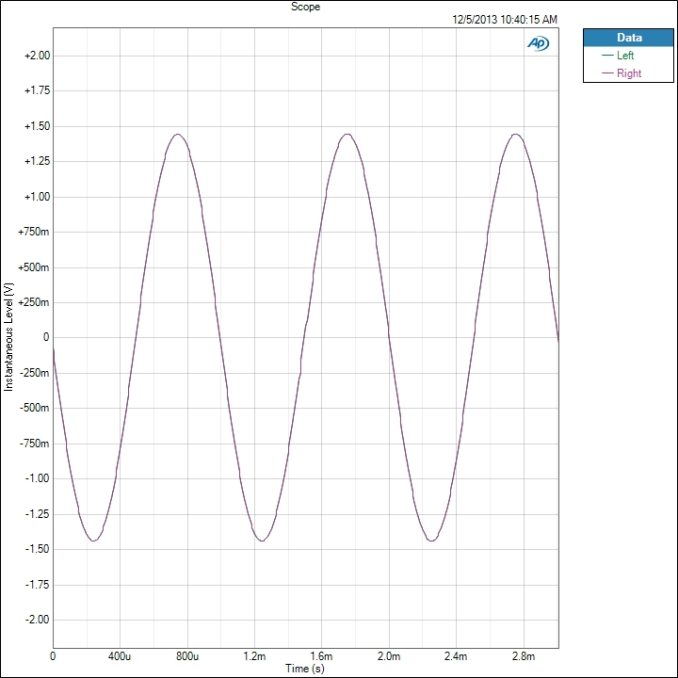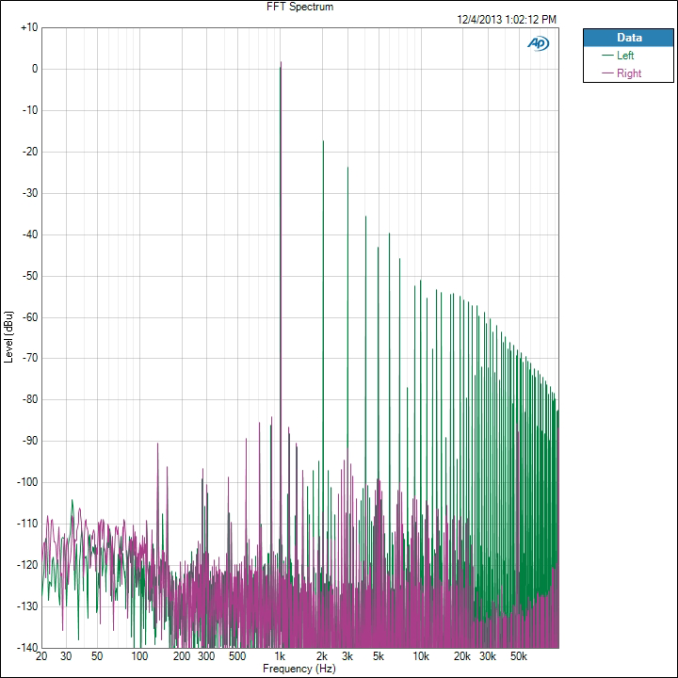Smartphone Audio Quality Testing
by Chris Heinonen on December 8, 2013 5:15 PM EST- Posted in
- Smartphones
- Audio
- Mobile
- Tablets
- Testing
THD+N is a measure of the total harmonic distortion and noise compared to the signal. The lower the number, the less distortion and noise there is relative to the fundamental frequency. THD+N is measured by driving a 1 kHz sine wave at maximum volume. Because there is always some inherent background noise, the THD+N is almost always lowest at maximum output so that is used for the measurement.
There are two results that we take from this: a sine wave and a FFT spectrum. On the sine wave both channels should line up perfectly, and it should be as close to an accurate sine wave as possible. On the FFT we want to see a peak at 1 kHz and everything else as low as possible. The most common artifact you will see are harmonic sidebands at multiples of 1 kHz.
For an example of data that looks good, here is the sine wave of the iPhone 5. We see a sine wave that is good, with channels that overlap perfectly and no deviation. This is what we expect to see.
Now for a different example we look at the Nexus 5. Run at maximum volume we see that the left channel is clipping in the sine wave. Likely the power to the headphone amplifier is not enough to drive both channels and so this is the result. UPDATE: Tested this with 4.4.1 and no change.
The iPhone 5 produces a THD+N ratio of 0.003134% while because of the clipping, the Nexus 5 is producing 13.789197%. Any level over 1% is considered to be past the clipping point of an amplifier and it seems that the Nexus 5 cannot be driven at maximum volume. I tested two samples to verify, and on both the performance is identical.
Now if we look at the FFT for this test, we see how this distortion is showing up. First, the iPhone 5 is very quiet.
There is a 2 kHz peak that is -93 dB below the fundamental frequency, and the 3rd harmonic at 3 kHz is over -109 dB below it. All the harmonics past that are at -120 dB below the fundamental tone. There is some noise out at 50 kHz but this is so far past the level of human hearing that it is safely ignored. Now the Nexus 5 FFT.
We see the right channel, which didn’t clip, looks good. The 2nd harmonic is -111 dB and the 3rd harmonic is -93 dB. On the left channel the 2nd harmonic is only -18 dB and the 3rd harmonic is -24 dB. Even at the 9th harmonic we are still only -52 dB below the fundamental tone. This is causing these incredibly high THD+N numbers that we are seeing on the Nexus 5. We will see more detail of this on a later test as well.
We also chart THD+N vs. Frequency. Here is the chart for the Note 3.
We see that THD+N is basically right below 0.08% for the whole spectrum. It moves up and down slightly, but is very constant. Now here is that Nexus 5 data.
We see that the right channel is around 0.01% THD+N while the left channel, the clipped one, is over 3%. If we ran the Nexus 5 at a lower volume level we would see totally different results, as you’ll find out later, but this is how devices are typically measured.
















188 Comments
View All Comments
Friendly0Fire - Sunday, December 8, 2013 - link
The Nexus S has some of the best DAC in the industry, actually... Most phones these days use the built-in Snapdragon DAC, but the S has a Wolfson DAC which is way superior.I think you either had a dud or you have another issue somewhere because the S was lauded for sound quality (just like the original Galaxy S).
tedders - Sunday, December 8, 2013 - link
I must have had a dud Galaxy S then too because my Captivate had abysmal audio.Samus - Monday, December 9, 2013 - link
The captivate and epic 4G (sprint variant) were substantially different from the galaxy s, although I remember the epic 4G touch (S2) having decent audio quality.tipoo - Sunday, December 8, 2013 - link
So I've heard, but I'm not the only one with shit audio on it, the running theory is they put in a good DAC but didn't bother properly making drivers or something for it.tipoo - Sunday, December 8, 2013 - link
Or perhaps improper shielding of the audio circuit from the radios, since the static seemed to be radio related. Even modern phones have some of that, even the best sounding ones like the iPhone 5S, but it's much much reduced.cheinonen - Sunday, December 8, 2013 - link
The DAC really means nothing without knowing everything else that goes into the circuit. Yes, the DAC might have superior SNR and THD+N but if you use an amplifier, or a volume control circuit, that are worse than other phones, you've now mitigated that advantage. It's there in the DAC but by the time it gets to the output stage it's been buried by noise elsewhere in the system.Using a better DAC is nice. But you can't just drop it in and get better results, everything else needs to be engineered around it as well.
Friendly0Fire - Sunday, December 8, 2013 - link
Using a higher end separate DAC hints that the manufacturer at least somewhat cares about sound quality. Using the built-in SoC DAC says that it's an afterthought.It's not a guarantee, but it's certainly an indicator.
Galidou - Sunday, December 8, 2013 - link
Totally agree with cheinonen, any high end audio stereo setup is as strong as it's weakest link. Take the excellent nuforce DAC-100 at ~1200$CAD, use it with a poor sub 400$ multi channel receiver and you won't get much out of it. The nuforce got plenty of amazing review, but it always depends on what it is paired with.The galaxy sure got a nice DAC but it's amplifier section is poorly engineered.
cjl - Monday, December 9, 2013 - link
Actually (and I know audiophiles everywhere will disagree with me on this, but whatever...), you can get audibly perfect sound with a dac worth only a couple hundred dollars at most, and an amp of similar cost. There's really no point in buying a >$1k dac, and the same goes for an amplifier (though expensive multi channel receivers can be justified, not for the quality of their amplifiers, but for the quality of their DSP, room correction, video upscaling, and variety of inputs and outputs). For an audio system, by far the most important component is the speakers. You should spend the vast majority of your audio budget on the transducers (speakers/headphones), then buy an amp with sufficient power to drive them to whatever level you need without distortion/clipping (which is almost always less power than recommended by audiophiles). The rest of the system can really be quite inexpensive - the built in DAC in most modern audio products is audibly flawless, and it's impossible to improve on 14AWG zip cord for the cables (from an audibility standpoint) unless you're running your wires over an extremely long distance.Now, that isn't to say that modern smartphones have reached that audibly flawless point yet - many of them haven't (especially when they have such blatant flaws as the single channel clipping shown in the review above), but many of them are a lot closer than people realize, and it really doesn't cost much to make a product audibly flawless. I remember seeing testing done on the latest iPod, and it was good enough to not contain any audible flaws. I would assume that the iPhone is similar, and the GS4 looks to also be audibly perfect in the review above (so long as 500mV p-p is sufficient to drive your headphones - this may not be the case for some less sensitive models).
speculatrix - Tuesday, December 10, 2013 - link
+1A lot of audiophile ideas simply don't stand up to basic engineering principles, and blind A:B tests show it.